 |
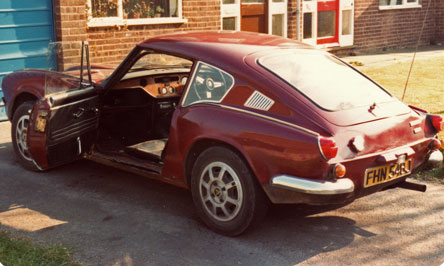 |
|
My car as purchased in March 1980 |
||
I have owned FHN 548J since March 1980 when I was only 31 years old! As they say, it has had one owner since 1980 (ignoring the previous 6). It was bought on the recommendation of an article called, ironically "Cars to Keep" written by motoring journalist/racing driver Roger Bell for the first issue of a magazine called "Old Motor", now defunct. Little did I know that I would keep it for nearly 40 years, and still counting! Originally I used it as a daily driver, when it visited such far flung places as London, Guildford, and Scotland (reputedly at the hands of the driver who stole it in Luton). My Dad tried to persuade me to sell it when I bought my first new car in 1982, an Austin Metro, but I decided to keep it as a second car! When my future wife Liz's car broke down in 1985, I lent the Metro to her, again using the Triumph as a daily driver. I remember using it for the first viewing of our present house in Chester. Just before we married she bought a more reliable car, a Hyundai Pony and the Triumph was again consigned to the garage. Over the years I used it occasionally until July 2000 when it failed its MoT. The high cost of raising a family of 3 meant that there were no funds to keep it roadworthy so it was laid up, and gradually became a glorified cupboard in the garage. The car was kept because I had owned it for so long that it had a place in my heart, becoming almost a member of the family! When I celebrated my 50th Birthday in 1998 my friend Garry even made a birthday cake in the shape of a GT6 (complete with brown patches of "rust"), see below:
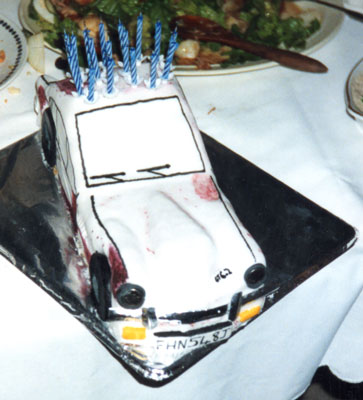
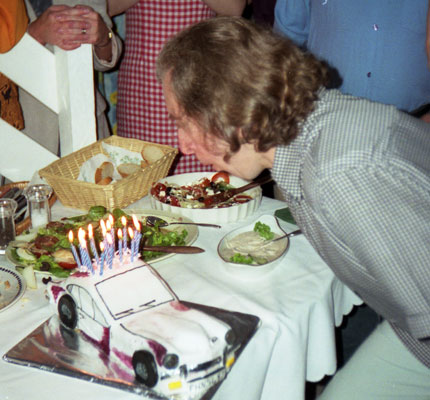
When I finally retired at the end of 2013 I had already made a start on it's second restoration by getting the engine going after being silent for over 12 years. Fortunately it sounded as good as ever; I had rebuilt it meticulously back in 1980.
I have tried to contact the previous owners but without success. The logbook and records kept by British Motor Industry Heritage Trust indicate that it was purchased from the Cleveland Car Company Ltd in Darlington by a Christopher McAndrew who lived at Dilston House, Aldbrough St John, Richmond, Yorkshire, the car's first "home". The McAndrew name is not uncommon in the Darlington area. Dilston House is a substantial property, and can be seen here. The car has now been in Chester for two-thirds of its nearly 50 year life and I will have owned it for 40 years in March 2020.
Below are details from my British Motor Industry Heritage Trust certificate of the car as manufactured:
| MY TRIUMPH GT6 MARK II | |
| Car/chassis number | KC/81893 |
| Engine number | KC/81742-HE |
| Body number | 76092/KC |
| Specification | RHD, Home Market |
| Colour, exterior | Damson |
| Colour, trim | Black (Ambla) |
| Date(s) built | 5 August 1970 |
| Date despatched | 26 August 1970 |
| Destination (dealer) | Cleveland Car Company Limited, Darlington |
| Other Numbers | Key Number FT.101 |
| Details of equipment | Disc wheels Heater 155-13 Dunlop SP.68 tyres |
| Other information | The Registration Mark FHN 548J was issued in Darlington in or after August 1970. |
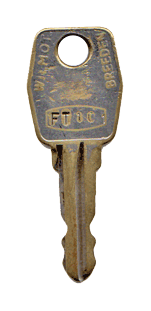
Above, the original key as per the British Motor Industry Heritage Trust certificate. Below, a period Dunlop SP68 advert.
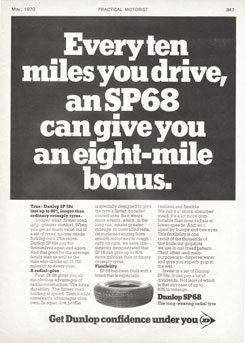
In the latest restoration I have tried to keep the car reasonably original. The exceptions (which are not allowed to compromise the essential character of the car) are as follows:
1. The Engine.
As the car used to be my main transport, reconditioning the original engine was not an option, so I obtained a spare engine though my friend Stephen Pilkington (below on the right outside my house with his MG), reconditioned that at my leisure, and changed over a week-end (13/14th December 1980) with the help of Stephen and another good friend Tony Smith. The engine was a 2.5 litre from a scrapped 1972 Triumph 2.5PI saloon for which I paid the sum of £10. At the time I don't think many GT6s had been uprated in this way, now it is more common. The bigger engine weighs about 14lbs more than the standard engine (approx 190kg versus 183kg, dry) because the longer throw crankshaft is much more substantial. Not original, but at least these engines are period! To counteract the additional 7kg weight I fitted an alloy water pump housing which saved 2.5lbs and removed the centre of the front bumper; both these removed around 2kg! Now, 39+ years later I can claim that the current engine is untouched since its sort of 'period' rebuild - the last Spitfire rolled off the production line in August 1980 and the Triumph Car Company soldiered on until 1984.
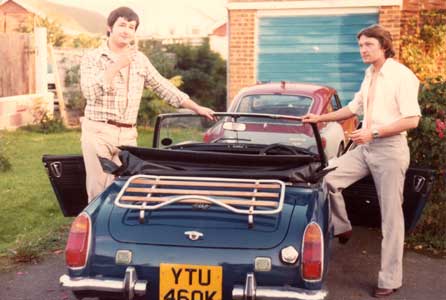
2. The Gearbox.
This needed reconditioning, and I wanted to upgrade to overdrive. To this purpose I obtained a D-Type overdrive gearbox from a GT6 Mk3 I, and a friend, broke up. In the event I decided to upgrade to heavier duty items to take the increased torque of the bigger engine. I had bid on ebay for an "Ultimate Uprated GT6 / Vitesse Lightweight J Type Overdrive Gearbox" built by Tony Lindsey Dean. However I just lost out to another higher bidder. Tony did email me offering to build another of the same specification, but in the event I asked well-known Triumph transmission guru Mike Papworth to build me a similar heavy duty gearbox with stronger components from later Triumphs, in a rare aluminium alloy casing, of which Canley Classics made a small batch. I asked Mike to number this KC81742 after the missing engine! This was matched to a later J-Type Laycock de Normanville overdrive, which is also stronger than the original D-Type. Most of these components have come from 1970s Triumphs. Fitting J type overdrives to the GT6 is not straightforward, but Mike has the expertise to know how to do it so it fits, using a standard GT6 Overdrive propshaft (which he supplied brand new).
3. The Body.
Although the body will have been restored twice, once in 1980 and again in 2016/17, almost without exception genuine Stanpart or Heritage panels (the latter allegedly made using original press dies) have been used. GT6s with totally original bodies are becoming exceedingly rare (and will become rarer), due to the prevalence of the 'tin worm'. The original colour was damson, which I didn't like at all! A fellow Mk2 owner I used to know who lived in Coepoeth had a white one which I saw once in Ruthin. I thought the colour really suited the car - evident from the number of examples I have seen in this colour. I also remember seeing a white TR5PI in a Triumph garage showroom in Birkenhead* where I took my then Triumph Herald Coupé in around 1969, which I loved! The beautiful car below features in a German magazine called Autobilde in an article called "Driving Report: Aston Martin DB6 and Triumph GT6" and shows how I intend my car to look when it's finished. Hopefully with Southside Classic & Custom really achieving excellent panel gaps it should look just as good as this.
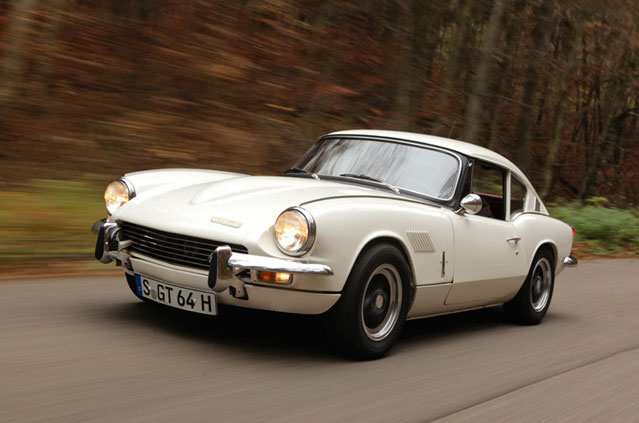
4. The Electrics.
I have completely renewed the wiring, making a custom 'loom' to suit any modifications with modern cables and a proper multi-fuse box for safety. To be honest, I don't see the difference between updating the wiring of a classic car and a historical property. Both need to be safe in the 21st Century. As I fiitted an uprated 65 amp alternator I uprated the wiring to take the heavier current.
5. The Ignition
As I wanted the reliability of electronic ignition I've upgraded to a brand new 123+ distributor, which has the benefits of being programmable by bluetooth, and also having a built in immobiliser for theft prevention. I have kept the original ignition components so the car can easily be changed back to standard specification.
Below 1970 Triumph Calendar showing the date the car was made. Coincidentally the picture for August was a GT6 Mk2!

* The showroom in question was R.E.Wright & Co. Ltd. A period advert appears below. According to WikiWirral, "the original garage was on Borough Road between Temple Road and Prenton Road West".
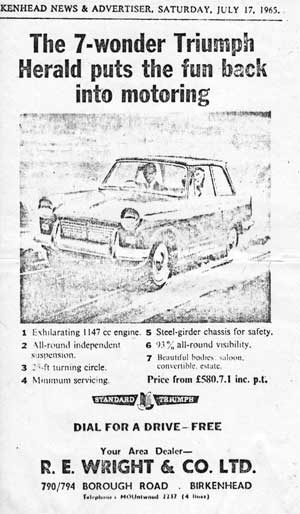
![]()